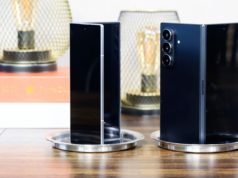Western Digital has a number of direct-attached storage (DAS) products based on hard drives. They cater to different market segments. These DAS units usually employ a USB port to connect to the host (Thunderbolt is also popular in the high-end market). Within the USB storage bridge market segment, Western Digital has a number of product lines tuned to specific use-cases. For example, the My Passport product line focuses on striking a balance between capacity and portability, while the My Book targets a ‘desktop’ use-case with external power, but much higher capacity.
The My Book and My Passport product lines were updated last week with a new industrial design. Western Digital has been selling these external storage devices with the highest storage capacity drives in their class for some time now (the 3.5″ 8TB version in the My Book, and the 2.5″ 4TB version in the My Passport). The refresh last week changes only the chassis and retains the internals from the previous model. Today’s review will take a look at the latest versions of the My Book and the My Passport.
The gallery below shows the updated chassis design of the two units and a look at the contents of the two packages. The aspects to note here include the 18W adapter bundled with the My Book, and the longer USB 3.0 cable bundled with it. The My Book unit also comes with a Kensington lock slot.
The new chassis design is definitely more stylish compared to the previous generation. Despite being more pleasing to the eye, certain segments of the chassis act as fingerprint magnets. Also, the new chassis design makes no improvements to the repairability aspect. We would prefer being able to get access to the bare drive in these units easily. This was an issue with the previous design, and it continues that way even with the new units. This is particularly important for the My Book, where a SATA drive is connected to a daughterboard containing the SATA-USB bridge chip (making it possible to use the SATA drive alone after pulling it out of the unit). For the My Passport, we find that the SATA – USB bridge is integrated on to the hard drive’s mainboard, and the USB port is the only available interface on the drive itself. A burnt-out bridge chip essentially means it is not possible for the average consumer to retrieve data from the drive in the case of the My Passport.
The table below presents the detailed specifications and miscellaneous aspects of the units and how they compare against other DAS units employing a single hard drive.
| Internal Drive Characteristics | ||
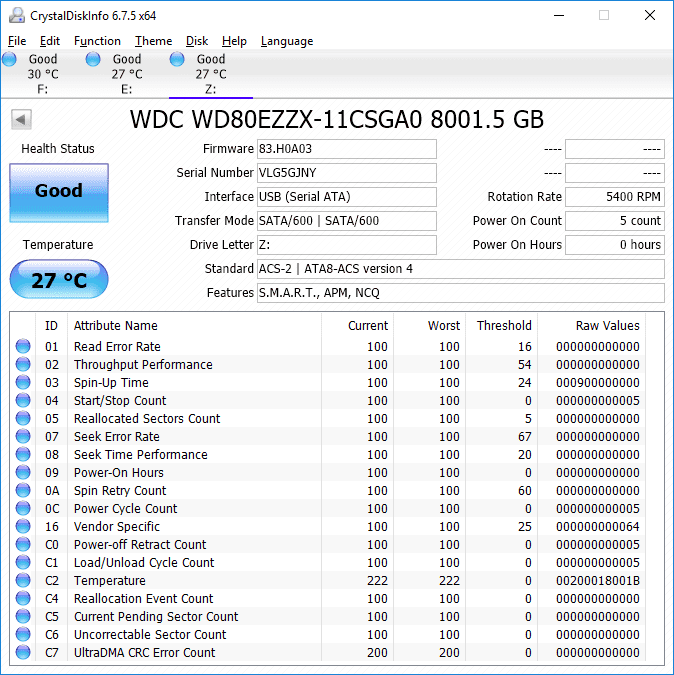 |
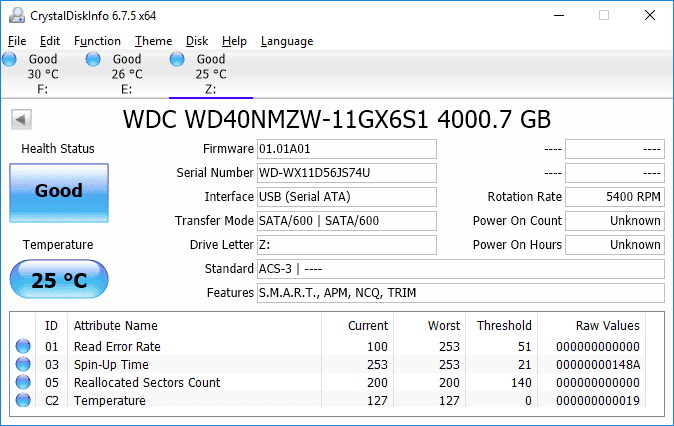 |
|
Our evaluation routine for hard-drive based direct-attached storage devices borrows heavily from the testing methodology for flash-based direct-attached storage devices. The testbed hardware is reused. CrystalDiskMark is used for a quick performance overview. Real-world performance testing is done with our custom test suite involving robocopy bencharks and PCMark 8’s storage bench.
CrystalDiskMark uses four different access traces for reads and writes over a configurable region size. Two of the traces are sequential accesses, while two are 4K rando accesses. Internally, CrystalDiskMark uses the Microsoft DiskSpd storage testing tool. The ‘Seq Q32T1’ sequential traces use 128K block size with a queue depth of 32 from a single thread, while the ‘4K Q32T1’ ones do random 4K accesses with the same queue and thread configurations. The plain ‘Seq’ traces use a 1MiB block size. The plain ‘4K’ ones are similar to the ‘4K Q32T1’ except that only a single queue and single thread are used.
The first interesting comparison in the table below is between the My Book with the 5400 RPM HelioSeal drive and the G-Technology G-Drive with Thunderbolt over USB 3.0 that employs a 7200 RPM HelioSeal drive. While the 1 MB sequential access traces show the 7200 RPM drive in better light, the use of a bridge chip supporting UASP helps the 5400 RPM My Book pull ahead by a huge margin in the high queue-depth sequential access trace.
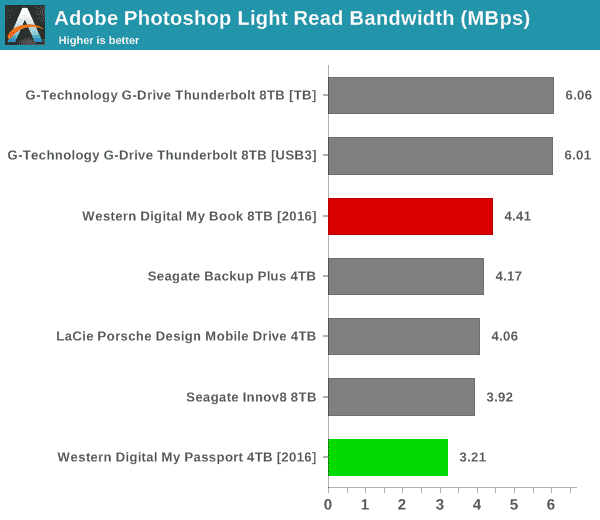
The thermal design of the enclosures for HDD-based DAS devices is important because hard drives can’t withstand as high a temperature range as flash-based devices. Higher temperatures tend to lower the reliability of the drives. In order to identify the effectiveness with which the enclosure can take away heat from the internal drive, we instrumented our robocopy DAS benchmark suite to record various parameters while the robocopy process took place in the background. Internal temperatures can only be gathered for enclosures that support S.M.A.R.T passthrough. Readers can click on the graphs below to view the full-sized version.
| Power Consumption – CrystalDiskMark | ||
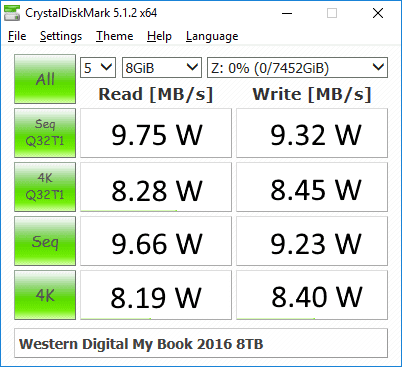 |
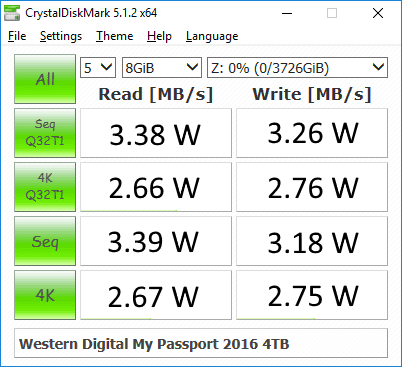 |
|
The power consumption numbers are not surprising – the AC-powered My Book 8TB consumes between 8W and 10W at the wall for different access traces, while the bus-powered My Passport 4TB consumes between 2.5W and 3.5W for the same. At idle, the My Book 8TB consumes around 6.9W, and that goes to 0W when the internal drive spins down. On the other hand, the My Passport 4TB consumes around 1.45W at idle, and, around 0.89W with the internal drive spun down.
There are a multitude of options targeting the same market segment when it comes to DAS units with single hard drives. As we saw in the performance evaluation section, there is really not much to differentiate between the various options in the same product class when it comes to the usage patterns of the average consumer. Most consumers would do well to choose the cheapest model at the time of purchase. In order to escape this rut of being a commodity, manufacturers have started to offer value additions to their DAS products. For example, Seagate bundles a backup application, cloud storage (200GB of OneDrive for two years) and the Lyve photo management app along with their DAS units. Western Digital also adopts a similar value-add strategy. We have the WD Backup application that can help keep a continuous backup of certain folders in a PC on the DAS unit.
Western Digital also includes a utility program and a security configuration program. The utility helps the users to run disk checks, configure the drive spin down time interval, turn off the LED (for the My Passport model) and secure erase the drive. The security program allows users to set a password for accessing the drive, with the option to unlock the drive for the current Windows account and do related management tasks.
Note that this password activates the AES-256 hardware encryption block on the drive (the encryption is in the drive, rather than the USB bridge chip) for both models. We ran CrystalDiskMark with an encrypted drive and found that there was no performance loss due to the activation of the security features.
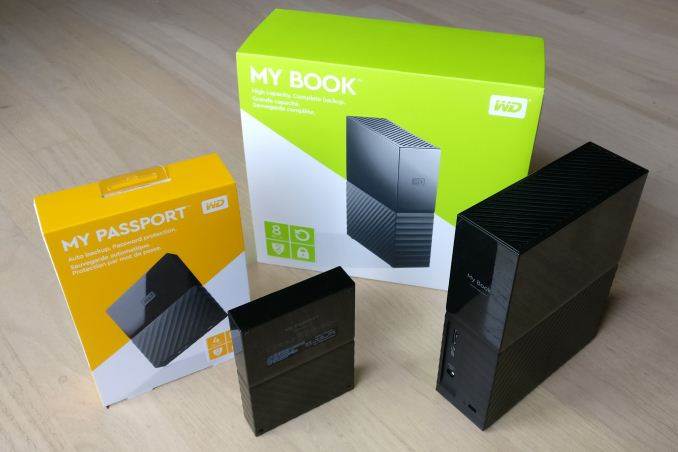
Coming to the business end of the review, the new My Book 8TB model retains the price of the earlier model – $250. This is much cheaper than the $349 of the Seagate Innov8, but priced around $35 more than the Seagate Backup Plus 8TB that comes with 200GB of cloud storage for two years. However, to WD’s advantage, it does sport a helium drive with consistent performance compared to the Archive HDD used in the offerings from Seagate. The My Passport 4TB pricing follows a similar trend. At $139, it is around $20 more than the Seagate Backup Plus Portable 4TB drive which comes with 200GB of cloud storage for two years. This drive is PMR-based and offers performance similar to the My Passport 4TB. That said, both the My Book 8TB and the My Passport 4TB offers hardware encryption, which might be worth the premium over 200GB of cloud storage for two years offered by the Seagate models for some users. Other than these aspects, there is little to differentiate the products from Seagate and Western Digital in this space. Consumers can choose either vendor / model depending on their requirements.












![[Design Story] One UI Helps You Live Life Your Way – Samsung](https://loginby.com/itnews/wp-content/uploads/2025/11/1763476351_Design-Story-One-UI-Helps-You-Live-Life-Your-Way-238x178.jpg)
